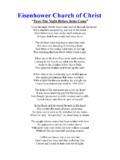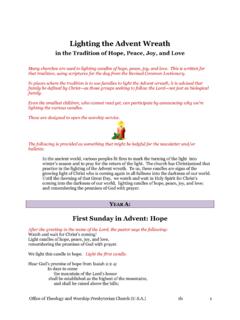Transcription of The Comprehensive Family Assessment Process
1 THE < strong >Comprehensivestrong > < strong >Familystrong > < strong >Assessmentstrong > < strong >Processstrong > A < strong >Comprehensivestrong > < strong >Familystrong > < strong >Assessmentstrong > is a < strong >Processstrong > , not the completion of a tool. This does not mean that tools are superfluous; they are helpful in documenting needs or in stimulating the conversation about < strong >Assessmentstrong > issues. It does mean, however, that the engagement of < strong >Familystrong > members in a discussion that is individualized to their situation is vital. Simply completing a form will not capture all that is needed for < strong >Comprehensivestrong > < strong >Assessmentstrong > . The initial < strong >Comprehensivestrong > < strong >Assessmentstrong > can build on the information obtained in previous assessments of safety and risk. All safety issues, progress on the safety plan, and areas of risk and strengths that have already been identified are explored as to their current impact on needs.
2 The < strong >Processstrong > includes assessing the < strong >Familystrong > s understanding of the safety and risk factors facing their children, examining what they have done already to address the concerns, what they consider to be the barriers to progress, and their most pressing needs in relation to the safety and risk factors. This information is then incorporated into the < strong >Comprehensivestrong > < strong >Familystrong > < strong >Assessmentstrong > and plans for services. Important information often arises from the first meeting with the < strong >childstrong > , youth, and < strong >Familystrong > and should be documented in the < strong >Comprehensivestrong > < strong >Familystrong > < strong >Assessmentstrong > . All information obtained during the < strong >Assessmentstrong > < strong >Processstrong > is used to develop the service plan. Key parts of the < strong >Processstrong > involve reviewing existing information, meeting with the < strong >Familystrong > , interviewing children and youth as appropriate, meeting with the staff of other agencies, obtaining specialized assessments, identifying the < strong >Familystrong > needs and circumstances contributing to the need for < strong >childstrong > welfare intervention, making judgments and decisions about services, documenting information and decision-making with the < strong >Familystrong > , doing ongoing assessments of progress and needs, and disseminating information to the < strong >Familystrong > and other providers to initiate and update the service plan.
3 I. Review Existing Information Review all relevant documentation that has emerged through: The initial review of records and summary of any past experience in the < strong >childstrong > welfare system or other related service systems; < strong >Comprehensivestrong > < strong >Familystrong > < strong >Assessmentstrong > Guidelines 22 What was learned from the reporter and collateral contacts; Initial contacts with the < strong >Familystrong > ; Safety assessments, including safety plans, and risk assessments; Observations of the home, interactions between adults in the home, parent/ < strong >childstrong > interactions, affect of < strong >childstrong > or youth (for example, confident, fearful); and Any specialized evaluations done as part of the initial < strong >Assessmentstrong > or in the recent past related to factors impacting children, youth, or adults in the home.
4 VIGNETTE 1: The Archuleta < strong >Familystrong > The vignette illustrates guidelines for a < strong >Comprehensivestrong > < strong >Familystrong > < strong >Assessmentstrong > (CFA) at two points in < strong >childstrong > welfare services: From the initial contact through the first < strong >Comprehensivestrong > < strong >Familystrong > < strong >Assessmentstrong > (approximately 60 days), and During the following months up to and including the next formal review. First < strong >Comprehensivestrong > < strong >Familystrong > < strong >Assessmentstrong > Preparation for Conducting the CFA A. Review of existing information: The referral, from an anonymous source, indicated that two children were alone in an apartment at 8:30 The children, Angela and Pablo, ages 4 and 8, were taken into custody when no caregivers could be found. A neighbor helped locate the children s mother s great aunt Tiana, who lives several miles away and the children were placed with her that evening.
5 As of now they remain in her care and have contact with their parents nightly by phone and semi-weekly face-to-face in supervised visits at the < strong >childstrong > welfare agency. On the night of the referral, the parents, Carmen, 22, and Arturo, 30, were at a friend s house and arrived home at midnight, finding a note that their children had been removed. They explained that they had left food for the children and a phone number where they could be reached. They had instructed Pablo to knock on a neighbor s door if he needed help. < strong >Comprehensivestrong > < strong >Familystrong > < strong >Assessmentstrong > Guidelines 23 Further < strong >Assessmentstrong > found that Arturo has a police record involving one conviction for petty larceny and two for dealing small amounts of cocaine.
6 Having served two sentences, he is now on parole. Both parents were tested for drugs, and their urine screen or urine analysis (UAs) tested positive for cocaine and marijuana. Carmen has never been in drug treatment. Two years ago Arturo spent two weeks in an outpatient drug treatment program before dropping out. He says that the program interfered with his job stocking shelves at a department store. Arturo likely will be re-incarcerated for a parole violation. The children have been left alone at least several times before. Parents say that they always leave a phone number and food for the children. Both parents indicated a strong desire to have their children returned and said that they will cooperate with the < strong >childstrong > welfare agency.
7 Carmen expressed interest in attending < strong >churchstrong > as she did when she was younger. She would like to go to her godparents < strong >churchstrong > . Interviews with the children, the parents, the godparents, the school and relatives indicated that Carmen and Arturo often provide adequate care for the children and that they and the children are attached; however sometimes the children are afraid and insecure. There is no evidence of physical or sexual abuse. The children sometimes fend for themselves when the parents are partying. There is an extended kin network, some of who are involved in drugs and have < strong >childstrong > welfare involvement and some of who are positive resources for the < strong >Familystrong > (for example, Carmen s great aunt Tiana, and Carmen s godparents).
8 B. Identify and document risks, strengths/protective factors, and possible needs to guide the < strong >Comprehensivestrong > < strong >Familystrong > < strong >Assessmentstrong > : Strengths/protective factors: Parents often provide adequate care for children, parents and children are bonded, parents want children back, some extended < strong >Familystrong > members are good resources to help the parents, parents are having consistent contact with children while in out-of-home care, mother wants to be involved in < strong >churchstrong > , < strong >Familystrong > is financially self-sufficient while father is present. Risks: Parents both use cocaine and marijuana, children have been < strong >Comprehensivestrong > < strong >Familystrong > < strong >Assessmentstrong > Guidelines 24 left alone before, parents believe children can take care of themselves for an evening, children are young, children are sometimes afraid and insecure, father has police record, father has dropped out of drug treatment once, and some of extended < strong >Familystrong > also has drug and < strong >childstrong > welfare involvement.
9 Possible service decisions: drug treatment for both parents, financial support for Carmen if Arturo is re-incarcerated, understanding of age-appropriate needs for children. C. Map out a plan for gathering < strong >Assessmentstrong > information: Talk with both parents about strengths/protective factors, resources and needs and assess readiness to use help and make change. The < strong >Familystrong > should be encouraged to engage in self- < strong >Assessmentstrong > about what they believe is happening and why they are now involved with the agency. Ask about cultural context of < strong >Familystrong > issues. Use ecomap and genogram with parents to record the information. Add to the ecomap and genogram after meeting with children, review of records, discussion with providers, and extended support system (the < strong >Familystrong > meeting).
10 Talk with both children about their concerns and needs. Obtain release of information as needed, review school, Head Start, and medical information on children and records from parole and drug treatment for Arturo. Talk with providers from these organizations as needed. Conduct a < strong >Familystrong > meeting. With the parents and great aunt who is the current caregiver, identify providers and < strong >Familystrong > /friends who should be invited. Make a plan for inviting and preparing all invitees for the meeting. II. Meet with the < strong >Familystrong > < strong >Familystrong > meetings with the parents and/or caretakers if the children are not living with their parents should occur as soon as possible after the < strong >childstrong > welfare agency has decided to open the case.











